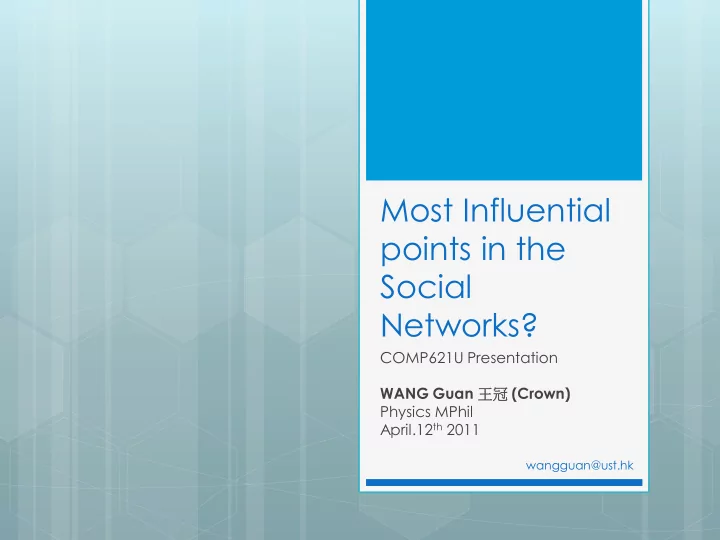

Most Influential points in the Social Networks? COMP621U Presentation WANG Guan 王冠 (Crown) Physics MPhil April.12 th 2011 wangguan@ust.hk
What are the most influential points In the social networks, or, any networks? Suppose you are Mega mind, where would you attack? wangguan@ust.hk
Outline 1. Community Bridges 2. Bridge Detection Algorithms 3. Proposed New Algorithms: Overlapping Community Detection Summary wangguan@ust.hk
1. Community Bridges [1] M. Salathé and J. H. Jones, Dynamics and Control of Diseases in Networks with Community Structure PLoS Comput.Biol 6 (2010) wangguan@ust.hk
[1] M. Salathé and J. H. Jones, Dynamics and Control of Diseases in Networks with Community Structure PLoS Comput.Biol 6 (2010) Question: How can we best control epidemics (prevention or mitigation)? How do we get maximum effect with given supply of vaccines? If we have a targeted immunization strategy, how do we find the targets? wangguan@ust.hk
wangguan@ust.hk
One can build networks with the same number of nodes, same number of edges, same degree distribution, and still get fundamentally different epidemic dynamics . Reason: Community Structures The occurrence of groups of nodes that are more densely connected within a group than between a group. Very common in many networks, especially social networks. wangguan@ust.hk
wangguan@ust.hk
Targeting highly connected individuals for immunization is an effective strategy to mitigate epidemics. Prediction of epidemics based on only degree fails. In networks with strong community structure, this may not be effective because some individuals connect to many communities but have low degree: These are community bridges . wangguan@ust.hk
Community Bridge Evaluation: Betweenness Centrality The fraction of shortest paths that a node falls on. How to find such community bridges?? wangguan@ust.hk
2. Bridge Detection Algorithms [1] M. Salathé and J. H. Jones, PLoS Comput.Biol 6 (2010). [2] M. E. J. Newman, Social networks 27, 39 (2005). [3] N. Madar, T. Kalisky, R. Cohen, D. Ben-avraham, and S. Havlin, The European Physical Journal B-Condensed Matter and Complex Systems 38, 269 (2004). Algorithms knowing Complete Network Structure: [2] Algorithms without knowing Complete Network Structure: [1][3] wangguan@ust.hk
Algorithms knowing Complete Network Structure Newman’s Random Walk Centrality algorithms. Identify target nodes by a random walk, counting how often a node is crossed by a random walk between two other nodes. This includes not only shortest paths but all paths between a pair of nodes, and it gives shorter paths a higher weight. This algorithm is actually used for community detection. [2] M. E. J. Newman, Social networks 27, 39 (2005). wangguan@ust.hk
Algorithms without knowing Complete Network Structure Cohen’s Acquaintance Method algorithms Fix a number N and identify target nodes by picking a random neighbor of a random node. Once a node (acquaintance) has been picked N times, we say this node is one of the most influential. When N = 1, it means every node is the one of the most influential. Work well in fat tailed (scale-free) networks. [3] N. Madar, T. Kalisky, R. Cohen, D. Ben-avraham, and S. Havlin The European Physical Journal B-Condensed Matter and Complex Systems 38, 269 (2004) wangguan@ust.hk
Algorithms without knowing Complete Network Structure cont. Salathe’s Community-bridge-finder (CBF) algorithms Start from a random node and follow a random path on the complex network until it arrives at a node that does not connect back to more than one of the previously visited nodes on the random walk Such a node is more likely to be on the “bridge”, and such nodes connect to multiple communities. The first node that does not connect back to previously visited nodes in the current random walk is likely to be in a different community. Here they are talking about social network, and thus each node should have at least more than two neighbors. [1] M. Salathé and J. H. Jones, PLoS Comput.Biol 6 (2010) wangguan@ust.hk
3. Proposed New Algorithms: Overlapping Community Detection [4] Xufei Wang, Lei Tang, Huiji Gao, and Huan Liu. Discovering Overlapping Groups in Social Media . In Proceedings of The 10th IEEE International Conference on Data Mining (ICDM'10), 2010 [5] Zhenggang Wang and K. Y. Szeto, Structure profile of complex networks by a model of precipitation , Physica A: Statistical Mechanics and its Applications, Volume 389, Issue 11, 1 June 2010, Pages 2318-2324 wangguan@ust.hk
Motivated by [1], we can have the following statement: The most influential nodes (links) in social networks can be the ones that belong to the largest number of multiple communities, known as “Community Bridges”. wangguan@ust.hk
Most influential links: Normal Community Detection! Once we find the communities of nodes, it’s easy to identify the links between those communities. Links between the biggest communities will be most influential. wangguan@ust.hk
Most influential nodes: Community Detection on the links! Nodes of links which belong to the most number of link communities will be the most influential ones. How do we find the communities of links ? wangguan@ust.hk
Edge-centric View Cluster edges instead of nodes into disjoint groups One node can belong to multiple groups. One edge belongs to one u group. 1 t 1 u In [4], they focus on a User- 2 t Tag subscription, which is a 2 u Bipartite Graph. t 3 We can generalize it to any 3 networks . u t 4 4 u 5 wangguan@ust.hk
[5] gives an interesting algorithm: wangguan@ust.hk
wangguan@ust.hk
[5] is basically a edge-clustering method. It is able to show nodes that belongs to a pair of communities. Question: Can we modify the algorithm to show better results for multiple (>2) overlapping communities? wangguan@ust.hk
Summary 1. Community Bridges 2. Bridge Detection Algorithms 3. Proposed New Algorithms: Overlapping Community Detection Questions? Thank you! wangguan@ust.hk
Recommend
More recommend